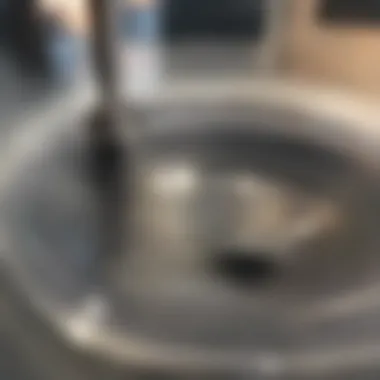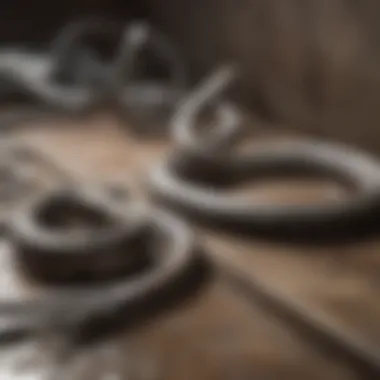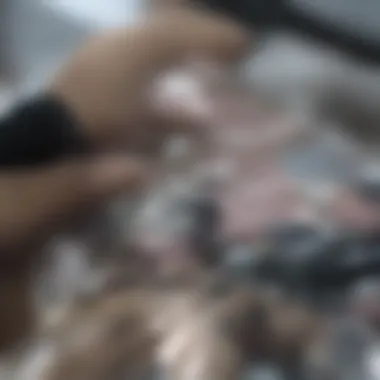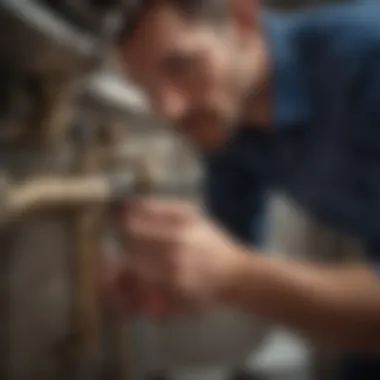Effective Methods for Unclogging Drains at Home


Intro
Unclogging drains is a common household issue that many people face. Clogs can develop in various drainage systems, whether in kitchens, bathrooms, or outdoor areas. Understanding the causes of these blockages helps in finding effective remedies. This article explores methods for unclogging drains, detailing both do-it-yourself solutions and when to call in professional experts.
By examining the tools and materials needed, as well as preventive measures, readers will gain practical knowledge. They will be better equipped to address drainage problems as they arise, enhancing the maintenance of their homes.
Feature Spotlight
Understanding Clog Causes
Several factors contribute to clogged drains. The most common culprits include:
- Accumulation of food particles in kitchen sinks
- Hair and soap residue in bathroom drains
- Tree roots invading underground pipes
- Grease build-up from cooking
Each of these causes presents unique challenges and solutions. Identifying the specific type of clog will determine the most effective unclogging approach.
Tools and Materials for Unclogging
To tackle drain clogs, a variety of tools and materials may be needed:
- Plunger: A basic yet effective tool for simple clogs.
- Drain Snake: Useful for deeper blockages that a plunger might not reach.
- Baking Soda and Vinegar: A natural and chemical-free solution for minor clogs.
- Professional Drain Cleaner: For persistent clogs that do not respond to basic methods.
By having the right tools on hand, homeowners can address drainage issues more efficiently.
DIY Techniques for Unclogging
There are numerous do-it-yourself methods for unclogging drains. Here are some of the most effective:
- Plunging: Capture the overflow of water in the sink or tub, and use a plunger to create suction. This method can be very effective for minor clogs.
- Baking Soda and Vinegar: Pour half a cup of baking soda followed by half a cup of vinegar down the drain. After it fizzes, wait for about 30 minutes, then flush with hot water.
- Using a Drain Snake: Insert the drain snake into the pipe, twisting it as you go, to remove buildup stuck in the line.
These techniques exploit common household items and are easy to execute.
Professional Solutions
In some instances, calling a professional plumber is necessary. Factors that indicate the need for an expert include:
- Persistent clogs that resist all home remedies
- Multiple drains in the home are clogged simultaneously
- Foul odors or unexplained backups
Professionals have access to advanced equipment and techniques, such as hydro jetting, which can resolve severe blockages while preventing future issues.
Preventive Measures
Taking steps to maintain clear drains is essential. Consider the following preventive tips:
- Regular Cleaning: Clean drains with baking soda and vinegar monthly to minimize buildup.
- Use Drain Covers: These can catch hair and food particles before they enter the pipes.
- Mind What Goes Down the Drain: Avoid pouring grease or large food scraps into sinks.
Taking proactive measures will save time and prevent costly repairs in the future.
Prelims to Drain Clogs
Understanding the underlying issues related to drain clogs is essential for home maintenance. Clogs not only impede the flow of water but can cause significant damage to plumbing systems, leading to costly repairs. Recognizing the signs and causes of clogs is the first step in maintaining efficient drainage in any household. This knowledge allows homeowners to take proactive measures, thereby avoiding more serious plumbing problems down the line.
It is crucial to identify and address clogs promptly. Moreover, a well-informed approach aids homeowners in selecting the appropriate tools or methods for unclogging drains. This article will discuss what drains are, how clogs occur, and several methods both DIY and professional to rectify the situation.
Understanding Drain Clogs
Drains are designed to facilitate the removal of water and waste from kitchens and bathrooms. However, the efficiency of this system can be compromised when various substances accumulate, leading to obstructions. These clogs can occur in various sizes and forms, impacting different settings in the home.
Clogs may start small but can escalate into larger blockages if left unattended. This escalation not only affects the usability of household systems but may lead to health risks from backed-up waste. By becoming familiar with the characteristics of drain clogs, a homeowner can better understand the importance of addressing these issues efficiently.
Common Causes of Clogs
Hair Buildup


Hair buildup is one of the most frequent culprits behind clogged drains, particularly in bathrooms. As hair accumulates in the pipes, it intertwines with soap scum and other debris. This combination can form a dense mass that obstructs water flow. The key characteristic of hair buildup is its ability to trap other materials, making the clog development even more severe.
Preventing hair from entering drains can be straightforward. Simple tools like drain guards can greatly reduce the amount of hair that reaches the plumbing system. On the downside, when clogs do occur due to hair, manual removal is often necessary, which can be labor-intensive.
Soap Scum
Soap scum is another common factor leading to clogs. The grease and dirt interact with soap residues to form a hard deposit on the insides of pipes. Over time, this buildup restricts flow. Soap scum can be particularly problematic in areas with hard water, where mineral content exacerbates the issue.
While soap scum is a well-recognized factor for blockages, it is also manageable through regular cleaning techniques. However, if ignored, it can mix with debris and lead to more substantial blockages that may require professional services to remove.
Food Waste
Food waste often leads to clogs, especially in kitchen sinks. Scraps that go down the drain can combine with grease and oils, creating thick clogs. Many homeowners are not fully aware of what can safely go down their kitchen drains. This ignorance can lead to problems that necessitate severe interventions.
On the positive side, proper disposal practices and the use of drain filters can greatly mitigate the risk of food-related obstructions. However, once food waste leads to a clog, it often requires more extensive cleaning methods such as snaking or hydro jetting to resolve.
Foreign Objects
Foreign objects are a significant cause of drain clogs. Items such as toys, utensils, and other miscellaneous objects can accidentally enter drains, blocking water flow. The presence of foreign objects is particularly common in household settings with children, where curiosity can lead to various mishaps.
The unique feature with foreign object clogs is that removal can often require specialized tools or professional plumbing skills. This situation can quickly escalate costs and time if not addressed immediately. Understanding the risk of foreign objects can assist in prevention and prompt action when issues arise.
DIY Methods for Unclogging Drains
Clogged drains can be a major inconvenience in a home. Exploring DIY methods is important because they offer practical solutions to common problems without the additional cost of professional services. By understanding these methods, homeowners can save money and tackle minor clogs effectively. Each method varies in application and effectiveness. It's essential to select the best option based on the nature and severity of the clog. Here, we'll take a closer look at several DIY techniques that can help restore proper drainage.
Boiling Water Technique
The boiling water technique is a simple method that can resolve many minor clogs. This approach works by liquefying soap scum, grease, and other buildup in your pipes. It relies on the heat to break down stubborn materials that can hinder water flow. To use this method, simply boil a kettle of water and pour it slowly down the affected drain. Repeating this process several times can often clear minor clogs effectively.
Key Consideration: Ensure that your pipes can handle high temperatures. Some older or weaker pipes may not withstand this method, which can lead to additional damage.
Using Baking Soda and Vinegar
Combining baking soda and vinegar creates a natural reaction that can be effective for clearing clogged drains. This method uses the chemical reaction produced by mixing these two ingredients to break down debris. First, pour a cup of baking soda down the drain, followed by a cup of vinegar. Close the drain to keep the reaction concentrated in the pipes, and allow it to sit for 30 minutes. Afterward, flush with hot water.
Benefit: This method is non-toxic and environmentally friendly, making it a safe alternative to harsh chemicals.
Manual Removal Techniques
Taking a hands-on approach can often yield effective results. Manual removal techniques involve physically getting rid of the material causing the blockage. Here are two commonly used methods:
Using a Plunger
Using a plunger is one of the most straightforward methods for unclogging drains. The plunger creates a vacuum that can dislodge clogs caused by grease, hair, and small debris. It is a beneficial choice because it is accessible and easy to use. To use a plunger effectively, ensure there is enough water in the sink or tub to cover the rubber end, then aim the plunger over the drain and pump vigorously. After a few up-and-down motions, you should notice a change in water flow.
Unique Feature: A key characteristic of the plunger is its ability to create pressure. This pressure can force the clog loose without the need for chemicals.
Snaking the Drain
The drain snake is a flexible tool that can reach deep into pipes to remove stubborn blockages. It works by breaking apart compacted materials to restore flow. This method is particularly effective for hair clogs in bathroom drains. Insert the snake into the drain while turning the handle. Once you encounter resistance, continue to twist and push until the clog clears.
Important Aspect: The flexibility and reach of the drain snake make it a popular choice. While it requires some manual effort, many find it to be a successful solution for persistent clogs.
Chemical Drain Cleaners
Chemical drain cleaners are often marketed as quick solutions for clogged drains. They contain potent substances designed to dissolve various types of clogs. While effective in some cases, they come with certain risks. Before attempting this method, it is crucial to understand the potential dangers.
Dangers of Chemical Cleaners
The dangers of chemical cleaners stem from their corrosive nature. They can harm not only the clog but also your pipes and the environment. Using these cleaners without proper precautions can lead to injuries and long-term damage to plumbing systems.
Key Issue: Always read the label and follow safety guidelines. Using these products indiscriminately can create more problems than they solve.


Choosing the Right Product
If you decide to use a chemical cleaner, it is vital to choose the right product for the specific issue. Different formulas target different types of clogs, such as hair, grease, or food. Read reviews and verify the product’s effectiveness. Not all chemical cleaners are suitable for all types of plumbing systems.
Consideration: Assess the damage and determine if a chemical cleaner is your best option compared to other less harmful methods.
Professional Solutions for Severe Clogs
When DIY methods fail to alleviate stubborn drain issues, professional solutions become not just an option but a necessity. Severe clogs can cause extensive damage to plumbing systems if not resolved quickly. Thus, understanding when to seek expert assistance is vital. Professional interventions often prevent further complications, which could lead to more costly repairs. Moreover, these solutions generally ensure greater effectiveness than household methods.
When to Call a Plumber
Recognizing the signs that indicate it’s time to call a plumber is crucial. Situations warranting professional help may include:
- Prolonged drainage issues that do not respond to conventional methods.
- Frequent backups or gurgling noises in the plumbing system.
- Water pooling around release points like sinks or toilets.
Calling a plumber may also be necessary for clogs involving foreign materials locked in the drainage system. Experienced plumbers possess specialized tools and skills to manage complicated situations effectively. Ignoring persistent issues can lead to worse problems down the line, including pipe damage or significant leaks.
Hydro Jetting
Hydro jetting offers a comprehensive solution for encumbered drains. This method employs high-pressure water jets to clear away tough blockages, including accumulated grease, sludge, and sediment. Hydro jetting not only clears clogs but also cleans the pipes, enhancing overall drainage efficiency. It is especially useful in commercial settings where drains are subject to heavy use, as well as in any home prone to repeated clogs.
Key advantages of hydro jetting include:
- Deep Cleaning: Effectively removes residue and build-up from the interior of pipes.
- Environmentally Friendly: Utilizes only water, without harmful chemicals that could harm plumbing systems.
- Prevention of Future Clogs: By removing residue, it decreases the likelihood of recurrence.
CCTV Drain Inspection
CCTV drain inspection involves using a camera to assess the condition of pipes and identify the root causes of clogs. This non-invasive technique provides a visual representation of the drainage system, allowing plumbers to make informed decisions on how to proceed with the necessary repairs or cleaning processes.
Benefits of CCTV inspection include:
- Accurate Diagnosis: Plumbers can detect issues like fractures, root intrusions, or serious clogs that are not visible through external inspection.
- Targeted Solutions: The ability to pinpoint exact problem areas results in more effective and often less costly repairs, as only the problematic sections need attention.
- Documentation: The visual footage can be documented for future reference or for assisting homeowners with claims or property evaluations.
Tools and Materials for Unclogging Drains
When dealing with drain clogs, having the right tools and materials can play a crucial role in effectively resolving the issue. The right equipment not only speeds up the process but also minimizes the risk of causing further damage to the plumbing system. This section will explore some essential tools and useful materials that enhance the unclogging process. Understanding these elements can save time, money, and effort, making the task of unclogging drains less daunting.
Essential Tools
Plunger
A plunger is perhaps one of the most common tools used for unclogging drains. Its design allows for creating a vacuum that can dislodge obstructions stuck in pipes. The main characteristic of a plunger is its rubber suction cup that effectively seals over the drain opening. This facilitates powerful up-and-down motions to break loose clogs. What makes it a preferential choice is its simplicity and ease of use. Most homeowners find a plunger accessible, and it requires no special skills.
One unique feature of the plunger is its versatility. It can be used not just for sinks but also for toilets and tubs. However, despite being effective for minor blockages, plungers may fail to address more severe clogs. Users should be cautious not to use excessive force, as this could damage piping.
Drain Snake
A drain snake, or drain auger, is a more specialized tool designed for deeper clogs. Unlike a plunger, it is long and flexible, allowing for navigation through pipes to reach clogs that are otherwise inaccessible. The main characteristic of a drain snake is its coiled wire that can break up or grab onto debris. This makes it a popular choice for persistent blockages.
One appealing aspect of the drain snake is its ability to handle tougher clogs. It can penetrate clogs caused by hair, grease, and other stubborn materials. However, its complexity might be a downside for some users. If used improperly, there is a risk of damaging the drain line. Therefore, it requires a careful approach and strategy for optimal use.
Bucket
A bucket is an indispensable tool during the unclogging process. While it may seem straightforward, its purpose is vital, especially when using a plunger or during manual removal techniques. The primary role of a bucket is to catch excess water and debris that may spill during the unclogging process.
The key characteristic of a bucket is its capacity to hold liquids. This makes it an essential choice for any unclogging task. A bucket prevents unwanted messes in the home, allowing for a neater and more organized approach. However, it may not directly contribute to clearing clogs but supports the overall process by maintaining cleanliness.
Materials to Consider
Baking Soda
Baking soda is a popular household ingredient used for its natural cleaning properties. In the context of unclogging drains, it serves as a gentle abrasive that helps breakdown minor clogs. The key characteristic of baking soda is its alkalinity, which reacts with acidic substances to create a fizzing action. This reaction can help dislodge debris stuck within pipes.


Baking soda is beneficial because it is non-toxic and safe for regular use. Unlike harsh chemical drain cleaners, it poses no risk to plumbing systems. However, its effectiveness may diminish when faced with severe blockages, where stronger methods are needed.
Vinegar
Vinegar, particularly white vinegar, is another eco-friendly solution for unclogging drains. When combined with baking soda, it creates a powerful fizzing reaction that can lift blockages. The primary characteristic of vinegar is its acetic acid content, which can dissolve soap scum, grease, and other buildups.
This material is favored for its effectiveness and safety. As with baking soda, vinegar does not harm plumbing and can be used regularly as a preventative measure. However, it may not be strong enough for more severe clogs, thus it is often used in conjunction with other methods.
Salt
Salt is a common household item that plays a unique role in maintaining clear drains. It can be used as an abrasive that aids in loosening up debris. The key characteristic of salt lies in its granular texture, which can scrub away buildup in pipes.
Salt is a beneficial choice because it is widely available and adds little cost to the unclogging process. It can be combined with hot water for better results. However, excessive use may lead to corrosion in metal pipes, which is a crucial consideration when applying this method.
Preventative Measures for Clog-Free Drains
Preventing drain clogs is often simpler and more cost-effective than dealing with them once they arise. Employing preventative measures not only maintains functionality but also extends the lifespan of your plumbing system. Keeping drains clear minimizes the need for frequent maintenance or costly repairs. Understanding how to safeguard against clogs is crucial for every homeowner.
Regular Maintenance Practices
Implementing routine maintenance can significantly reduce the occurrence of clogs. Regular cleaning is essential. For instance, pouring boiling water down drains weekly can help dissolve grease and debris. Using a mixture of vinegar and baking soda monthly is another effective practice. This combination actively breaks down buildup inside pipes. A drain snake should be used periodically to clear minor obstructions before they escalate into larger problems.
- Inspecting your drains regularly helps identify early signs of clogs.
- Consider maintaining a log of maintenance actions. This practice establishes a clear record, assisting in timely interventions when needed.
Installing Drain Guards
Drain guards act as physical barriers to prevent debris from entering your plumbing system. These simple tools can be incredibly effective. They come in various materials and designs to suit different types of drains. Including mesh or screen models, which are easy to clean and durable.
- Place drain guards in sinks, showers, and bathtubs.
- Regular cleaning of these guards is essential to maintain their effectiveness.
- It is a simple, yet efficient way to significantly reduce hair and other solids entering the pipes.
Educating Household Members
Knowledge is power when it comes to maintaining clog-free drains. Educating all household members about what can and cannot be flushed or washed down the sink is essential. Informing them about the importance of proper disposal of food waste, grease, and hygienic products will aid in ensuring drains remain clear.
Encourage everyone to participate in maintaining the home’s plumbing. Regular discussions about the symptoms of potential clogs can help everyone stay vigilant. You could even create simple guides to share best practices that everyone can follow. Informative posters placed near sinks and toilets can serve as reminders.
Ultimately, the collaboration of all household members is key to maintaining an efficient drainage system.
By taking these steps—establishing regular maintenance, installing drain guards, and educating your household—you can significantly reduce the likelihood of encountering clogged drains. These simple, proactive measures enable homeowners to enjoy uninterrupted use of their plumbing systems.
Culmination
Summary of Effective Practices
A variety of practices are discussed throughout the article that equip readers with practical insights. Here is a brief summary of those effective methods:
- DIY Methods: Techniques such as using boiling water, baking soda and vinegar, and manual removal via plungers or snakes serve as quick and cost-effective solutions for minor clogs.
- Professional Solutions: For more severe situations, enlisting the help of a plumber and utilizing methods such as hydro jetting and CCTV inspection can resolve persistent drainage problems efficiently.
- Preventative Measures: Regular maintenance, installation of drain guards, and educating household members on proper disposal practices can greatly reduce the incidence of clogs.
"Prevention is key to maintaining clear drains. Simple actions taken regularly can save homeowners from costly repairs and inconveniences."
Further Resources
In any discussion around maintaining clear drainage systems, the value of accessible, well-curated resources cannot be overstated. Understanding the nuances of unclogging drains is essential, and the right materials can significantly enhance one’s ability to tackle these common household dilemmas. When referencing further resources, we refer to a wide range of materials that educate homeowners, DIY enthusiasts, and even professionals in the field about best practices, tools, and preventive measures regarding drainage systems.
Importance of Further Resources
- Education and Awareness: The first step to effectively addressing drainage issues is understanding the various causes and methods of prevention. Resources available on platforms like Wikipedia or Britannica often dive into the science behind plumbing mechanics. This encourages a deeper grasp of what goes wrong with drainage systems, helping individuals recognize early warning signs of clogs.
- Practical Guides and Tutorials: Many resources provide step-by-step guides that break down each method for unclogging drains, ensuring both novices and experienced individuals can follow along. These guides can come from community forums like Reddit, where users share personal experiences and solutions that have worked for them.
- Product Recommendations and Reviews: Selecting the right tools and chemicals can be overwhelming. Leveraging resources that offer objective reviews and product comparisons, like what is found on Facebook groups dedicated to home improvement, can save time and effort. This information promotes informed decision-making about the tools and materials needed, ensuring effectiveness and safety.
Benefits to the Audience
- Informed Choices: Accessing these resources allows readers to make informed choices about how to approach drainage issues. This is pivotal in determining whether a DIY method is suitable or if it is time to call a professional.
- Cost Savings: DIY solutions highlighted in these resources often lead to significant cost savings. Understanding the most effective methods can reduce the need for professional services.
- Long-term Prevention: Learning about maintenance and preventative measures equips homeowners with the knowledge to keep their drains clear. This makes it possible to avoid the hassle and expense associated with severe clogs in the future.
Considerations When Seeking Additional Resources
While further resources greatly enhance understanding, it is essential to approach them with discernment. Not every guide or method is applicable to all situations. Homeowners should consider the following:
- Accuracy of Information: Verify the credibility of the resource. Reliable platforms usually provide evidence-backed information and anecdotal accounts that can be cross-referenced.
- Community Feedback: Pay attention to user comments and experiences. Community feedback can guide your decisions, offering insights that might not be present in formal guides.
- Expert Opinions: When available, seek resources that include expert opinions, as these add a layer of credibility and depth to the information presented.
"A well-maintained drainage system is crucial to a healthy home environment. Knowledge from credible resources can empower homeowners to manage this effectively."







